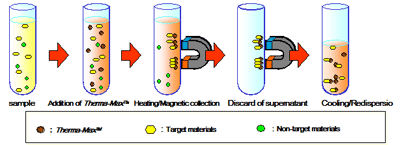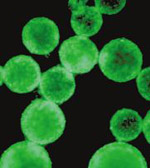2007 Archive
Magnetic hyperthermia makes the cover page in the Journal of Nuclear Medicine
 An interesting article about the targeting of human breast
cancer in mice with magnetic nanoparticles containing radiolabeled antibodies has just appeared in the Journal of Nuclear Medicine (De Nardo SJ et al, J Nucl Med 48, 437-444). The scientists could show that the nanoparticle tumor concentration correlated with heat induction by magnetic hyperthermia and also with tumor growth delay. Excellent work!
An interesting article about the targeting of human breast
cancer in mice with magnetic nanoparticles containing radiolabeled antibodies has just appeared in the Journal of Nuclear Medicine (De Nardo SJ et al, J Nucl Med 48, 437-444). The scientists could show that the nanoparticle tumor concentration correlated with heat induction by magnetic hyperthermia and also with tumor growth delay. Excellent work!
World's Largest Superconducting Magnet Switches On
 Click to enlarge. |
The Atlas Barrel Toroid consists of eight superconducting coils, each in the shape of a round-cornered rectange, 5 m wide and 25 m long, with a weight of 100 tonnes, all aligned to millimeter precision. It will work together with other magnets in Atlas to bend the paths of charged particles produced in collisions at the LHC.
Therma-Max

Therma-Max is an aqueous solution of thermo-responsive magnetic nano particles showing a property of reversible phase transition between disperse and aggregate as temperature changes, and therefore, can be easily applied to separation of targeting bio-substances. Since the size of Therma-Max is extremely small, the magnetic nano beads have large surface area to be conjugated with ligand for capturing targeting materials by comparing with currently used micron sized magnetic beads. Therefore Therma-Max has much higher capacity than micron sized magnetic beads.
Find out more about Therma-Max at http://www.magnabeat.com.
Nanoparticles and Occupational Health
 You have probably occasionally heard discussions about the toxicity of (magnetic) nanoparticles. Many articles have been written about this subject, especially in the lay press, and the dangers of nanoparticles have generally been hyped with very little scientific basis. A new book has been published which looks at occupational health effects of nanoparticles in depth. Check it out, all the chapters are currently available for free at http://www.springerlink.com/content/p13817kll818/.
You have probably occasionally heard discussions about the toxicity of (magnetic) nanoparticles. Many articles have been written about this subject, especially in the lay press, and the dangers of nanoparticles have generally been hyped with very little scientific basis. A new book has been published which looks at occupational health effects of nanoparticles in depth. Check it out, all the chapters are currently available for free at http://www.springerlink.com/content/p13817kll818/.
If you want to check it out in book form, see the citation in our book section.
Our Magnetic Carrier Conference in the Media
 A few stories have appeared about our 2006 Magnetic Carrier Meeting in Krems, Austria. Please check them out!
A few stories have appeared about our 2006 Magnetic Carrier Meeting in Krems, Austria. Please check them out!
The most complete is the article in Nanotoday 1, 34-39 (2006) titled "Nanomagnetism shows in vivo potential" written by Paula Gould.
The others are online articles. The first is available on medicalphysicsweb and covers the use of magnetic nanoparticles in general: http://medicalphysicsweb.org/
The second covers the use of magnetic nanoparticles (SPIO) as contrast agents and specifically for cell tracking: diagnosticimaging.com
Magnetic Viewing Film
 You have probably seen them before, these films, which make visible magnetic fields. They consist of magnetic (nano) particles in a carrier fluid, which has been embedded between two pieces of plastic film. The external magnetic field directs the magnetic particles in a magnet-characteristic way, and together with birefringence, pictures like the one to the right show up.
You have probably seen them before, these films, which make visible magnetic fields. They consist of magnetic (nano) particles in a carrier fluid, which has been embedded between two pieces of plastic film. The external magnetic field directs the magnetic particles in a magnet-characteristic way, and together with birefringence, pictures like the one to the right show up.
The magnetic viewing films are sold by serveral companies:
http://www.forcefieldmagnets.com/catalog/
http://www.matchrockets.com/ether/magfilm.html
Wind Power Breakthrough
 China has developed wind turbines that use magnetic levitation to generate superior amounts of power compared to current turbines in use. Check out the full story here or here.
China has developed wind turbines that use magnetic levitation to generate superior amounts of power compared to current turbines in use. Check out the full story here or here.
It looks like all this is just a new type of fraud. See at this website
http://peswiki.com/index.php/Talk:Directory:MagLev_Wind_Power_Generator
SPRI - Cutting Edge Magnetic Bead Technology
The Agencourt SPRI (Solid Phase Reversible Immobilization) technology is a patented purification technology developed at MIT's Whitehead Institute (Hawkins, et. al., Nucleic Acids Res. 1995 (23): 4742-4743). It is a simple and highly efficient means of microplate-based nucleic acid isolation used extensively in the Human Genome Project. Nucleic acids are immobilized onto paramagnetic microparticles using specific buffer conditions. Flexibility is added to the system through modification of the binding buffer, which alters the type and size of immobilized nucleic acid. Sample contaminants are easily removed without the need for labor-intensive centrifugation or filtration, thus creating an automation-friendly format. More information is available at http://www.agencourt.com/.


 Photo of the Month Archive
Photo of the Month Archive